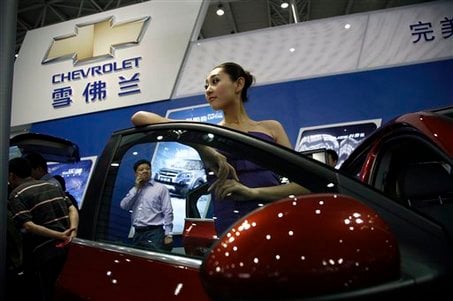GM Lives And Dies With China

TTAC has written many times about the growing dependency on China, and now there is a voice that says that GM is more enslaved to China than it is to Washington.
“The irony is that, while the Obama administration claims credit for saving General Motors, China actually did. GM sold 2.5 million vehicles in China in 2011. Moreover, these cars were sold at high prices. China probably has accounted for over 100% of GM’s profits over the past five years, i.e., it is losing money elsewhere.”
While many will debate that number, and will show spreadsheets that say that it is not true, the dependency of GM on China is a fact. GM sells more cars through its Chinese joint ventures than at home in the U.S. GM had to sell half of its India business to GM’s Chinese joint venture partner SAIC. During GM’s darkest hours, SAIC co-signed a loan that kept the lights on at GM. Careful books are being kept in China for favors granted, and GM will regret many times that it had to ask for this favor.
The car industry in China is suffering from more overcapacity than that of Europe. An Alix Partner study pegs the overall capacity utilization in the Chinese auto industry at 67.3 percent. Anything below 80 percent is considered toxic in this industry. According to Alix Partners, “this is an issue that affects international OEMs just as it affects local companies, as the resultant price-discounting can wind up affecting the entire industry’s pricing structure.”
Some comments from Chinese CEOs at the Global Automotive Forum in Chengdu were quite desperate. It is expected that Chinese companies will try to find salvation in an export push at low prices, and that the Chinese government will help by lowering the Chinese currency, which it had lifted to appease America. Already, the past steady rise of the Yuan against the dollar has stopped in 2012.
This can spell trouble for GM on several fronts:
- A drop in auto sales in China
- Eroding margins in China
- Lower earnings when converted into dollars
- Increased competition and pricing pressure in other markets
Volkswagen, also hugely dependent on China, has a similar exposure. Toyota, at only 883,000 vehicles sold in China in 2011, is less exposed.
(Hat tip to l’Avventura.)

Bertel Schmitt comes back to journalism after taking a 35 year break in advertising and marketing. He ran and owned advertising agencies in Duesseldorf, Germany, and New York City. Volkswagen A.G. was Bertel's most important corporate account. Schmitt's advertising and marketing career touched many corners of the industry with a special focus on automotive products and services. Since 2004, he lives in Japan and China with his wife <a href="http://www.tomokoandbertel.com"> Tomoko </a>. Bertel Schmitt is a founding board member of the <a href="http://www.offshoresuperseries.com"> Offshore Super Series </a>, an American offshore powerboat racing organization. He is co-owner of the racing team Typhoon.
More by Bertel Schmitt
Latest Car Reviews
Read moreLatest Product Reviews
Read moreRecent Comments
- Corey Lewis It's not competitive against others in the class, as my review discussed. https://www.thetruthaboutcars.com/cars/chevrolet/rental-review-the-2023-chevrolet-malibu-last-domestic-midsize-standing-44502760
- Turbo Is Black Magic My wife had one of these back in 06, did a ton of work to it… supercharger, full exhaust, full suspension.. it was a blast to drive even though it was still hilariously slow. Great for drive in nights, open the hatch fold the seats flat and just relax.Also this thing is a great example of how far we have come in crash safety even since just 2005… go look at these old crash tests now and I cringe at what a modern electric tank would do to this thing.
- MaintenanceCosts Whenever the topic of the xB comes up…Me: "The style is fun. The combination of the box shape and the aggressive detailing is very JDM."Wife: "Those are ghetto."Me: "They're smaller than a Corolla outside and have the space of a RAV4 inside."Wife: "Those are ghetto."Me: "They're kind of fun to drive with a stick."Wife: "Those are ghetto."It's one of a few cars (including its fellow box, the Ford Flex) on which we will just never see eye to eye.
- Oberkanone The alternative is a more expensive SUV. Yes, it will be missed.
- Ajla I did like this one.


































Comments
Join the conversation
Not surprisingly, a headline eviscerating GM while VW, which is even more exposed in China gets a small mention at the end. 1st off, GM makes more of its profits in the US than in China w/ its higher margin truck sales and the combined sales of higher margin Cadillac and Buick. As the Cadillac and Buick lineups get expanded, the 2 will generate even greater profits for GM in the US. Right now, Cadillac sales in China are relatively low since GM imports Cadillacs to China, but that's going to change with Chinese production of the ATS and XTS. VW is much more exposed to China since their other main market, Europe, is going thru an economic crisis, and b/c Audi is what drives the vast majority of profits at VW and Audi's largest market w/ Europe is China. Now if the anti-Japanese sentiment continues in China, both GM and VW may benefit, alleviating somewhat the market conditions. Also interesting (but hardly surprising) that there is no mention of Ford, which has already built 2 plants in China and is building at least 3 more.
What exactly is the problem with GM living or dying on the back of its Chinese sales? M-B,and BWM were in the same situation with the U.S market for many years.